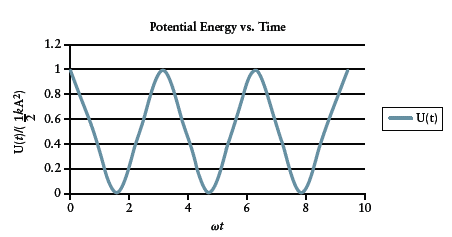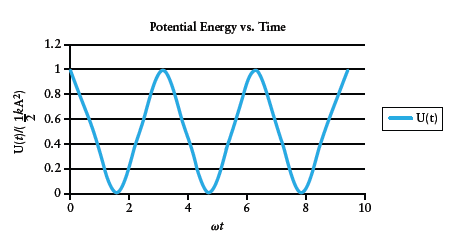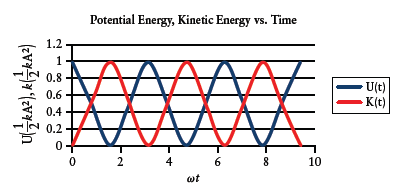
Concept explainers
(a)
To plot:
The graph of potential energy versus time for three full periods of motion.
Answer to Problem 51QAP
The plot of potential energy is as below:

Explanation of Solution
Given data:
The potential energy of a simple harmonic oscillator,
Calculation:
The equation of motion for a given simple harmonic oscillator is
The potential energy of a simple harmonic oscillator is given by
The plots of U ( t ) should look like those for
For simplicity, the vertical axis of the following plot is

Figure 1
Conclusion:
Thus, the plot of potential energy versus time for three full periods of motion is shown in Figure 1.
(b)
The expression for the velocity,
Answer to Problem 51QAP
The expression for the velocity is given by,
Explanation of Solution
Given data:
The potential energy of a simple harmonic oscillator,
Calculation:
The equation of motion for a given simple harmonic oscillator is
The velocity of this oscillator is given by Equation,
Conclusion:
Thus, expression for the velocity,
(c)
To plot:
The graph of Kinetic energy on the same graph where potential energy versus time is drawn.
Explanation of Solution
Given data:
The potential energy of a simple harmonic oscillator,
Calculation:
The equation of motion for a given simple harmonic oscillator is
The velocity of this oscillator is given by equation,
The potential energy of a simple harmonic oscillator is given by
And the kinetic energy is given by
The plots of U ( t ) and K ( t ) should look like those for
For simplicity, the vertical axis of the following plot is

Figure 2
Conclusion:
Thus, the plot of kinetic energy versus time and potential energy versus time is shown in Figure 2.
Want to see more full solutions like this?
Chapter 12 Solutions
COLLEGE PHYSICS LL W/ 6 MONTH ACCESS
- A man slides two boxes up a slope. The two boxes A and B have a mass of 75 kg and 50 kg, respectively. (a) Draw the free body diagram (FBD) of the two crates. (b) Determine the tension in the cable that the man must exert to cause imminent movement from rest of the two boxes. Static friction coefficient USA = 0.25 HSB = 0.35 Kinetic friction coefficient HkA = 0.20 HkB = 0.25 M₁ = 75 kg MB = 50 kg P 35° Figure 3 B 200arrow_forwardA golf ball is struck with a velocity of 20 m/s at point A as shown below (Figure 4). (a) Determine the distance "d" and the time of flight from A to B; (b) Determine the magnitude and the direction of the speed at which the ball strikes the ground at B. 10° V₁ = 20m/s 35º Figure 4 d Barrow_forwardThe rectangular loop of wire shown in the figure (Figure 1) has a mass of 0.18 g per centimeter of length and is pivoted about side ab on a frictionless axis. The current in the wire is 8.5 A in the direction shown. Find the magnitude of the magnetic field parallel to the y-axis that will cause the loop to swing up until its plane makes an angle of 30.0 ∘ with the yz-plane. Find the direction of the magnetic field parallel to the y-axis that will cause the loop to swing up until its plane makes an angle of 30.0 ∘ with the yz-plane.arrow_forward
- A particle with a charge of − 5.20 nC is moving in a uniform magnetic field of (B→=−( 1.22 T )k^. The magnetic force on the particle is measured to be (F→=−( 3.50×10−7 N )i^+( 7.60×10−7 N )j^. Calculate the y and z component of the velocity of the particle.arrow_forwardneed answer asap please thank youarrow_forward3. a. Determine the potential difference between points A and B. b. Why does point A have a higher potential energy? Q = +1.0 C 3.2 cm 4.8 cm Aarrow_forward
 Physics for Scientists and Engineers: Foundations...PhysicsISBN:9781133939146Author:Katz, Debora M.Publisher:Cengage Learning
Physics for Scientists and Engineers: Foundations...PhysicsISBN:9781133939146Author:Katz, Debora M.Publisher:Cengage Learning Principles of Physics: A Calculus-Based TextPhysicsISBN:9781133104261Author:Raymond A. Serway, John W. JewettPublisher:Cengage Learning
Principles of Physics: A Calculus-Based TextPhysicsISBN:9781133104261Author:Raymond A. Serway, John W. JewettPublisher:Cengage Learning Classical Dynamics of Particles and SystemsPhysicsISBN:9780534408961Author:Stephen T. Thornton, Jerry B. MarionPublisher:Cengage Learning
Classical Dynamics of Particles and SystemsPhysicsISBN:9780534408961Author:Stephen T. Thornton, Jerry B. MarionPublisher:Cengage Learning University Physics Volume 1PhysicsISBN:9781938168277Author:William Moebs, Samuel J. Ling, Jeff SannyPublisher:OpenStax - Rice University
University Physics Volume 1PhysicsISBN:9781938168277Author:William Moebs, Samuel J. Ling, Jeff SannyPublisher:OpenStax - Rice University Physics for Scientists and EngineersPhysicsISBN:9781337553278Author:Raymond A. Serway, John W. JewettPublisher:Cengage Learning
Physics for Scientists and EngineersPhysicsISBN:9781337553278Author:Raymond A. Serway, John W. JewettPublisher:Cengage Learning Physics for Scientists and Engineers with Modern ...PhysicsISBN:9781337553292Author:Raymond A. Serway, John W. JewettPublisher:Cengage Learning
Physics for Scientists and Engineers with Modern ...PhysicsISBN:9781337553292Author:Raymond A. Serway, John W. JewettPublisher:Cengage Learning





